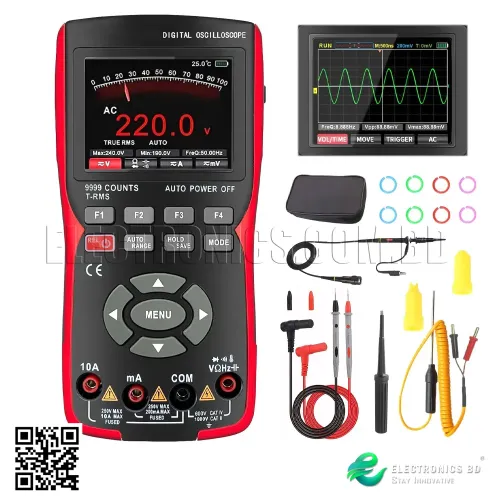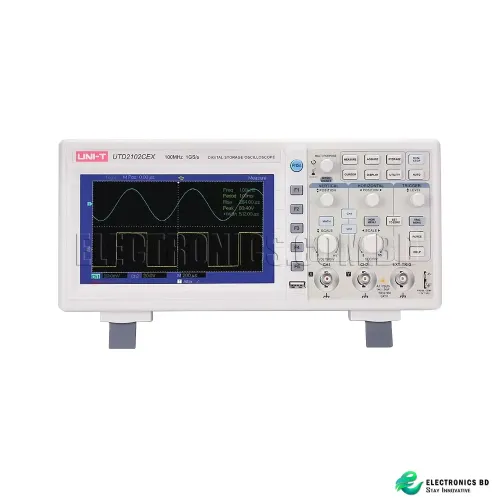- 3D printers & CNC
- Accessories
- Active Components
- All Departments
- CNC Accessories
- Electrical Accessories & IOT
- Latest
- Oscilloscope
- Passive Components
- Projects
- SMD Components
- Socket, Port & Jacks
- Sound Systems
- Drones & RC Hobby
- Sale
Your shopping cart is empty!
- Load Cell Type: Parallel Beam Strain Gauge
- Sensing Capacity: 10kg
- Wheatstone Bridge Structure: Half-Bridge
- Excitation Voltage: 5V to 10V DC
- Rated Output (mV per Input V): 1mV/V
- Internal Bridge Resistor: 1000Ω
- No. of Cable Leads: 4
- Measuring Precision: ±0.05%
- Recommended Interfacing Module: HX711 Load Cell ADC Amplifier
- Housing Material: Aluminium Alloy
- Mounting Holes: 2 x M5 | 2 x M4
- Dimensions: 12.7 x 12.7 x 80mm
Product Description
What is the Load Cell - 10kg Straight Bar ?
The Load Cell - 10kg Straight Bar is a precision sensor designed for accurately measuring weights up to 10 kilograms. Featuring a Parallel Beam Strain Gauge type and a Half-Bridge Wheatstone Bridge Structure, this load cell ensures reliable and stable performance in weight measurement applications.

Key Specifications:
- Sensing Capacity: 10kg
- Excitation Voltage: 5V to 10V DC
- Rated Output: 1mV/V (millivolts per input volt)
- Internal Bridge Resistor: 1000Ω
- Measuring Precision: ±0.05%
- Recommended Interfacing Module: HX711 Load Cell ADC Amplifier
- Housing Material: Aluminium Alloy
- Mounting Holes: 2 x M5 | 2 x M4
- Dimensions: 12.7 x 12.7 x 80mm
Crafted with durability in mind, this load cell is housed in an aluminium alloy casing and features mounting holes for convenient installation. With its precise measurement capabilities and compatibility with the HX711 Load Cell ADC Amplifier, it offers a reliable solution for various weight sensing applications.
Features:
- Precision Weight Measurement: Designed for accurately measuring weights up to 10 kilograms with a high level of precision, ensuring reliable results in various applications.
- Strain Gauge Technology: Utilizes a Parallel Beam Strain Gauge type with a Half-Bridge Wheatstone Bridge Structure, enhancing sensitivity and accuracy in weight detection.
- Wide Excitation Voltage Range: Operates efficiently with an excitation voltage range of 5V to 10V DC, providing flexibility in power supply options.
- Stable Output: Offers a rated output of 1mV/V (millivolts per input volt), delivering consistent and stable readings for precise weight measurement.
- High Measuring Precision: Provides a measuring precision of ±0.05%, ensuring minimal margin for error in weight readings.
- Compatible Interfacing Module: Recommended for use with the HX711 Load Cell ADC Amplifier, enabling seamless integration and amplification of load cell signals for enhanced accuracy.
- Durable Construction: Constructed with a robust aluminium alloy housing, ensuring durability and reliability in various environments.
- Easy Installation: Features mounting holes for convenient installation, allowing for easy integration into different systems or applications.
- Compact Design: Compact dimensions of 12.7 x 12.7 x 80mm make it suitable for space-constrained installations while maintaining its high performance capabilities.
How the Load Cell - 10kg Straight Bar Works ?

The Load Cell - 10kg Straight Bar operates based on strain gauge technology, which measures the deformation (strain) of the load cell when subjected to weight or force. Here's how it works:
Strain Gauge Arrangement: The load cell contains strain gauges arranged in a Wheatstone bridge configuration. When a weight is applied to the load cell, it causes the metal beam to deform slightly, changing the resistance of the strain gauges.
Excitation Voltage Application: An excitation voltage (typically between 5V to 10V DC) is applied to the load cell. This voltage energizes the strain gauges within the Wheatstone bridge circuit.
Output Measurement: As the strain gauges change resistance due to deformation, the Wheatstone bridge becomes unbalanced. This imbalance generates a small electrical signal proportional to the applied force or weight.
Amplification and Processing: The output signal from the load cell is typically weak and requires amplification for accurate measurement. It is then processed by an interfacing module such as the HX711 Load Cell ADC Amplifier.
Conversion to Weight: The amplified signal is converted into weight units using calibration factors. By calibrating the load cell with known weights, the relationship between the electrical signal and the applied force or weight can be established.
Display or Data Logging: The converted weight data can be displayed on a digital screen, transmitted to a computer or microcontroller for further processing, or logged for record-keeping purposes.
Frequently asked questions (FAQ):
What is a load cell and how does it work?
- A load cell is a transducer that converts mechanical force into an electrical signal. It typically contains strain gauges that change resistance when deformed by a load, generating a voltage output proportional to the applied force.
What are the different types of load cells?
- Load cells come in various types, including strain gauge load cells, hydraulic load cells, pneumatic load cells, and capacitive load cells. Each type has unique operating principles and applications.
How accurate are load cells?
- Load cell accuracy depends on factors like design, calibration, and environmental conditions. High-quality load cells can achieve accuracies within fractions of a percent of the rated load.
What are common applications of load cells?
- Load cells are used in various industries for tasks such as weighing systems, force measurement, material testing, industrial automation, and process control.
How do I calibrate a load cell?
- Load cells require calibration to ensure accurate measurement. Calibration involves applying known loads to the load cell and adjusting its output signal to match the expected values. Calibration procedures vary depending on the type and design of the load cell.
Similar Products:
Load Cell HX711AD Weight Sensor

















